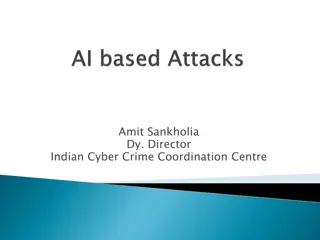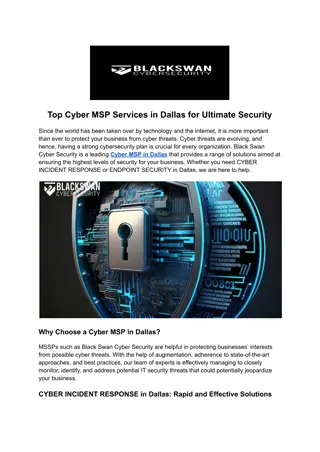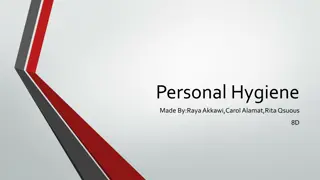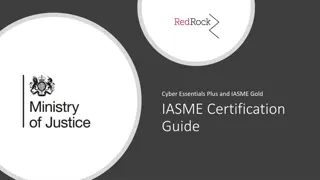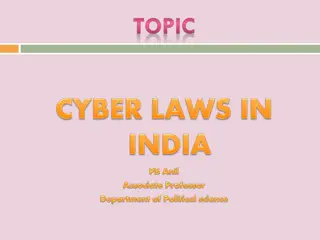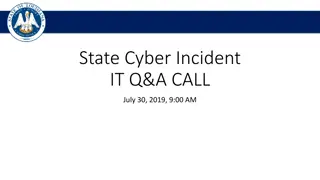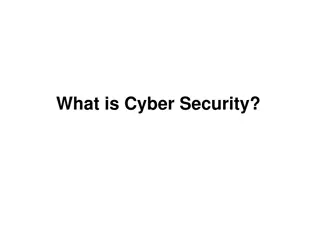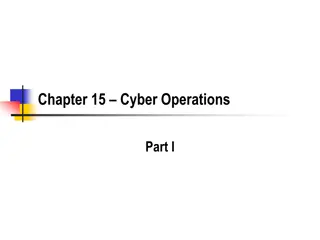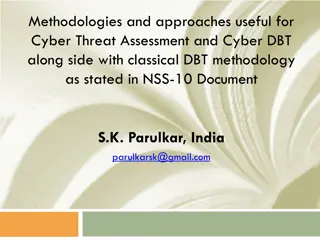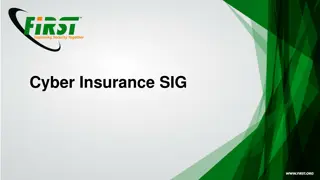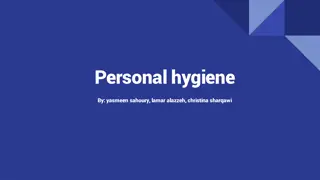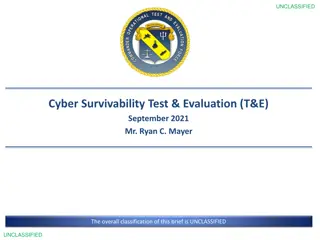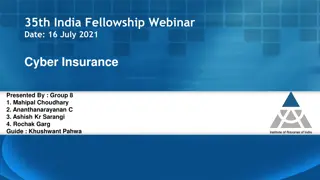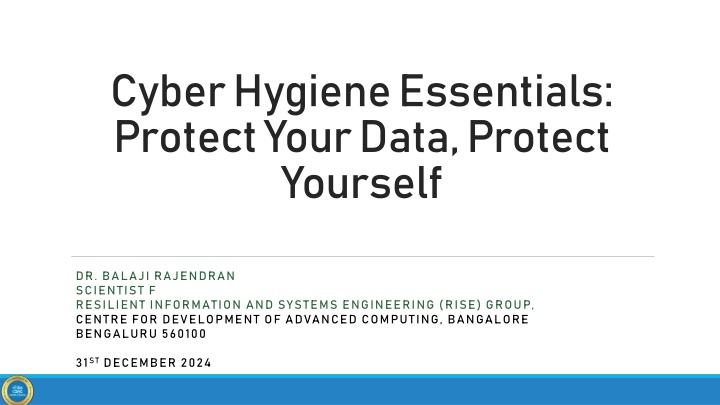
Cyber Hygiene Essentials for Data Protection and Online Safety
Learn the essential cyber hygiene practices to safeguard your digital life from cyber threats, including strong passwords, multi-factor authentication, secure Wi-Fi connections, software updates, data backup, and more. Stay vigilant on scrupulous websites, limit information sharing, monitor accounts, and be cautious when downloading software. Protect yourself by creating smart passwords, identifying fake websites, and reporting any incidents to cybercrime authorities.
Download Presentation

Please find below an Image/Link to download the presentation.
The content on the website is provided AS IS for your information and personal use only. It may not be sold, licensed, or shared on other websites without obtaining consent from the author. If you encounter any issues during the download, it is possible that the publisher has removed the file from their server.
You are allowed to download the files provided on this website for personal or commercial use, subject to the condition that they are used lawfully. All files are the property of their respective owners.
The content on the website is provided AS IS for your information and personal use only. It may not be sold, licensed, or shared on other websites without obtaining consent from the author.
E N D
Presentation Transcript
Cyber Hygiene Essentials: Protect Your Data, Protect Yourself DR. BALAJI RAJENDRAN SCIENTIST F RESILIENT INFORMATION AND SYSTEMS ENGINEERING (RISE) GROUP, CENTRE FOR DEVELOPMENT OF ADVANCED COMPUTING, BANGALORE BENGALURU 560100 31STDECEMBER 2024
Cyber Hygiene Practices and habits that help protect our digital life from cyber threats Report incidents to www.cybercrime.gov.in or call on 1930
Practices and habits to ensure Cyber Hygiene Strong Passwords Multi-Factor Authentication Secure Wi-Fi Connections Software Updates Data Backup Beware of Phishing Report incidents to www.cybercrime.gov.in or call on 1930
Protecting Yourself on Scrupulous Websites Be Vigilant: Pay attention to the website's URLand look for any signs of misspellings or unusual characters. Usage of special characters Check for security indicators like HTTPSand a padlock / tune icon in the address bar. Limit Information Sharing: Only provide necessary information when creating accounts or making purchases. Be cautious about sharing personal details like your date of birth or card details Monitor Your Accounts: Regularly review your bank and credit card statements for any unauthorized transactions. Report incidents to www.cybercrime.gov.in or call on 1930
Downloads Download only essential software Download directly from the software vendors website Be very cautious about: Free Download Free Keys Free Software Download apps only from the authorized sources Report incidents to www.cybercrime.gov.in or call on 1930
Password Strong and Smart password Personal Information in Password makes it a weak password Regularly change and avoid repeating the password Keep your passwords as secret Create Personalized Pass Phrases and use them in your password creation criteria Report incidents to www.cybercrime.gov.in or call on 1930
Identifying Fake Websites Always check the URL Usage of digits Usage of special characters Length of the URL (62 characters) Number of dots (3 dots) Example: www.cdac.in(2 dots) HTTPS is Ok!HTTP is bad! Language Tone Report incidents to www.cybercrime.gov.in or call on 1930
Phishing Attack- Illustration Link should NOT have IP address Report incidents to www.cybercrime.gov.in or call on 1930
Phishing Attacks Illustration - Emails support-information188382 Alpha-numeric email id Unrelated Link Report incidents to www.cybercrime.gov.in or call on 1930
HTTP vs. HTTPS http://shopping.com Report incidents to www.cybercrime.gov.in or call on 1930
HTTP Traffic Monitoring In HTTP protocol the Username and Password and sent without encryption. Report incidents to www.cybercrime.gov.in or call on 1930
HTTPS Traffic Monitoring In HTTPS protocol the application data(username and password) is encrypted.
Malicious Domain Checker This indigenous tool can check any domain and tell if the domain is harmful https://coednssecurity.in 13
Popular Carriers of Malware APK 14
Symptoms of a Malware-Infected-Device Automatic reboot/ shutdown Slow processing Increase in number of Processes Increased Disk Usage Sluggish Internet Intermittent pop- ups Spike in CPU usage 15
Real-time approaches for Malware Detection Network Usage CPU Usage Sudden spike Network traffic and logs DNS and IP tracking Sudden spike Slower response Process forking System response Non-responsive System logs Disk Usage Increase disk access List of files, their usage and access 16
9 common tricks by Scammers Phone Call Scam Fraudsters claim to be from TRAI, stating your mobile number is linked to illegal activities, and services will be suspended. Reality: TRAI doesn't suspend services; telecom companies do. Parcel Stuck at Customs Scammers claim a parcel with contraband has been intercepted and demand payment. Action: Disconnect and report the number. Digital Arrest Fake police officers threaten digital arrest or online interrogation. Reality: Police don't conduct digital arrests or online interrogations. Report incidents to www.cybercrime.gov.in or call on 1930
9 common tricks by Scammers Relative arrested Scammers claim a relative will be arrested and demand payment. Action: Verify with family members before taking action. Get Rich Quick Trading Social media ads promise high returns on stocks / currency trading Reality: High-return schemes are likely scams. Easy Tasks for Big Rewards Scammers offer high sums for simple tasks, then ask for investment. Reality: Easy money schemes are scams. Report incidents to www.cybercrime.gov.in or call on 1930
9 common tricks by Scammers Credit Card Issued in Your Name Fake executives confirm large transactions on bogus credit cards. Action: Check with your bank. Mistaken Money Transfer Scammers claim incorrect transactions and ask for refunds. Action: Verify transactions with your bank. KYC Expired & Generous Tax Refund Fraudsters pose as tax officials, asking for bank details. Reality: Tax departments already have bank details and communicate directly. Report incidents to www.cybercrime.gov.in or call on 1930
Internet Safety Measures Install Antivirus/Anti-Malware solution Be Cautious while sharing personal or financial information Avoid opening suspicious email (loans, prizes, donations) Shop only at reputed ecommerce sites Check security features Check authenticity Customer reviews Keep receipts, order details and tracking numbers safe Report damaged or faulty merchandise Report incidents to www.cybercrime.gov.in or call on 1930
Internet Safety Measures Use strong and stringent passwords Logout apps, Close apps Keep software up-to-date Disconnect suspicious calls immediately Don t share OTP, account number, CVV, card number, expiry date Avoid public WiFi networks Avoid scanning QR codes, without enquiring Download only from PlayStore or AppStore Report incidents to www.cybercrime.gov.in or call on 1930
Deep Fakes Artificial Intelligence generated forgeries that appear convincingly genuine False images, audio or video Solution: Awareness - Communicate with the concerned members before taking any action Report incidents to www.cybercrime.gov.in or call on 1930
Conclusion Cyber hygiene is essential for protecting your digital life. By following these simple tips, you can significantly reduce your risk of cyberattacks and data breaches. Remember, protecting your data is an ongoing process. Stay vigilant and adapt your practices as needed. Report incidents to www.cybercrime.gov.in or call on 1930


